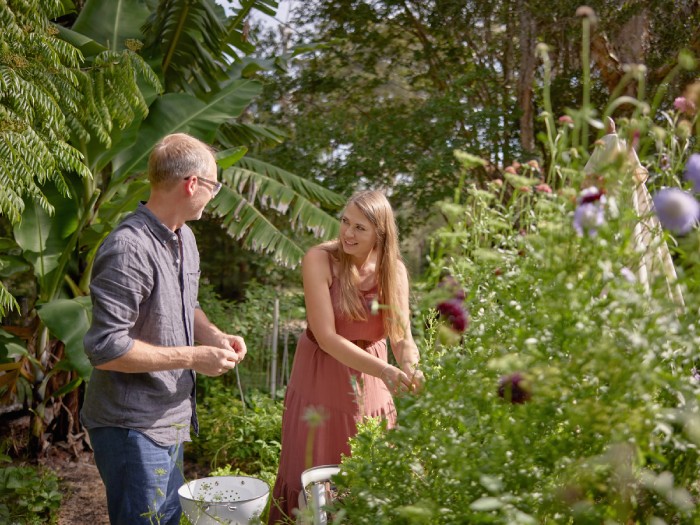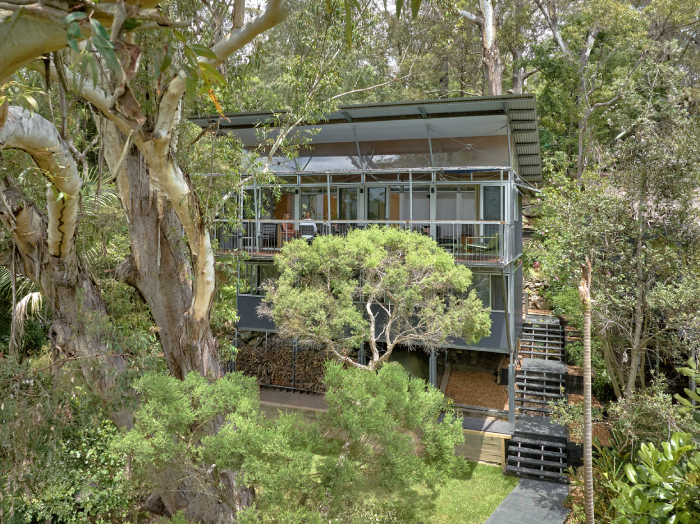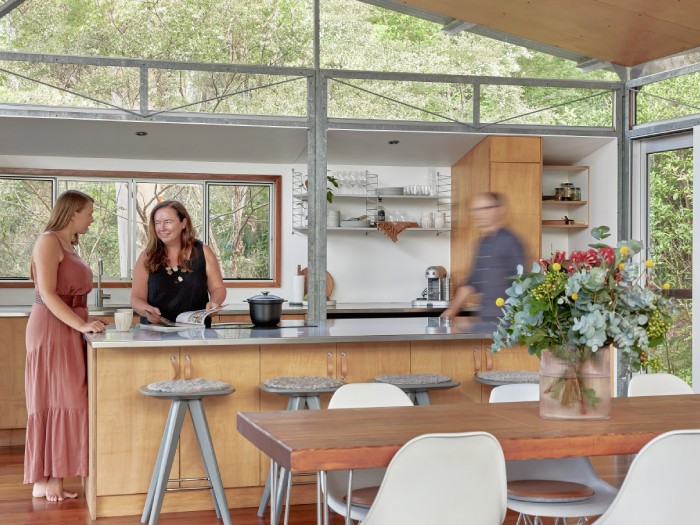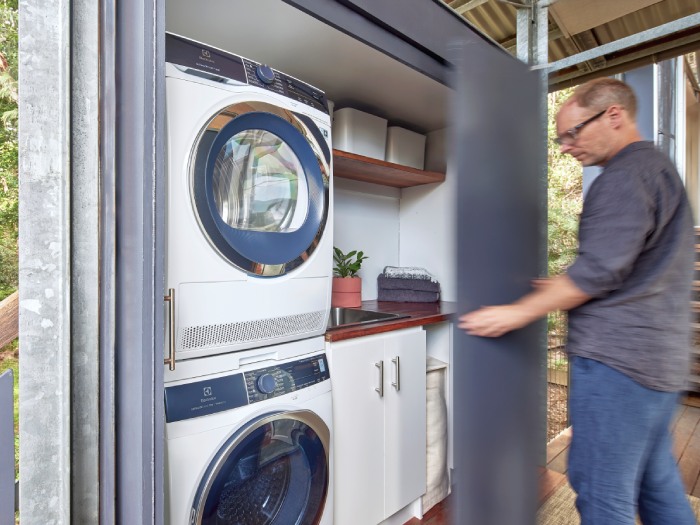Nestled amongst the old-growth Blackbutt trees of Sydney's Dangar Island, The Perch’s rudimentary silhouette establishes an amicable dialogue with the surrounding landscape. Designed by renowned architect Sue Harper, this timeless dwelling consists of three pavilions elevated on steel posts to ensure the structure disturbs as little of the undergrowth as possible. Expansive windows flood the generous living spaces with natural light, while suspended walkways weaving amongst the trees connect the interiors. This tranquil home, perched in synergy with the sloped landscape, offers a sense of immersion with minimal environmental impact.

Just the right amount
Owners Scott King and his partner Elina fell in love with the property upon returning to Australia in 2019, after six years in Sweden. As Electrolux’s Global Design Director of Cooking Appliances, Scott found Sweden's culture and lifestyle resonated deeply with his design ethos. The couple sought a similar, simpler way of life in Australia.
“This search led us to Dangar Island on the northern edge of Sydney,” Scott says. “The Swedes have a special connection to nature. The winters can be long and harsh, so they embrace summer when it arrives, packing up and leaving the cities to head to small summer houses scattered amongst the Swedish Archipelago. In this way life becomes much more connected to nature, you have to find food locally and embrace the long summer days with family and friends.”
Simple, functional, and idyllic with sweeping views of the Hawkesbury River, The Perch evoked the summer house feeling they craved. “It was not too much, not too little, just the right amount. In Swedish, they even have a word for it,” Scott smiles. “It’s lagom.”

Designed to last
Built two decades ago, this perfectly balanced dwelling remains an enduring testament to sustainability through timeless design and harmonious connection to nature. "The house has a low impact footprint, and abundant natural light makes it easy to passively heat," Scott explains. "Plus, it's at the perfect fly-by height for the island's bird life, who often stop over to enjoy the view with us."
Seamlessly fusing timeless aesthetic and enduring construction, Harper prioritised using natural materials like concrete, timber and stone to ensure low maintenance and durability – this sustainable choice of quality materials reduces the need for frequent renovations and minimises material waste over time. The house's modular design and exposed steel frame emphasise simplicity and longevity, and were awarded HIA ‘Most Innovative Use of Steel’ award in 2004
With extensive experience working in challenging conditions – like Arnhem Land and the Top End – Sue invariably designs buildings for site, climate and place, and occupant comfort. A physical expression of her design ethos, Mihaus, is a prefabricated, modular and adaptable studio system. This award-winning invention ensures minimal on-site construction waste, and a finished structure that seamlessly integrates into a variety of environments.
As a model use of the system, The Perch’s structure prioritises sustainable materials like fibre cement sheeting, hardwood floors, plywood, steel framing, and hemp insulation. The use of skillion roofs maximise natural light and ventilation, while the galvanised steel frames are bolted together with interchangeable wall, window, and door panels. This galvanised structure resonated with Scott's industrial design background.

“It provides a very product-like expression,” he points out, drawing comparison to his own industrial design practice with Electrolux. “There is the consumer facing part of our products which you see in your kitchens every day, and there is the mechanical structure where everything happens, that we use a lot of durable materials like galvanised metal. The structure gives the house a sense of robustness.”
He also sees connections to Electrolux product development in the Meccano-like construction, and modularity of the dwelling. "There is a simplicity to the structure," he says. "Its first purpose is always to be a place to come and relax. It's designed to live in, not intended as a showpiece.”
Electrolux: Sustainability by design
Scott emphasises that for Electrolux, user-centric product design is not just about aesthetics, but enhancing daily life. “Design is insight and data driven. It’s about working with the world's largest kitchen companies, chefs, architects, and Interior designers to understand future kitchen trends,” he enthuses. “And perhaps most importantly, it’s about being invited into homes around the world and sharing in the everyday passion of cooking to find those insights to deliver better taste experiences."
The Electrolux appliances found in The Perch’s kitchen exemplify this approach. Designed to meet rigorous sustainability standards while offering unparalleled performance, the products – all boasting superior European energy efficiency ratings – work hard to help reduce the home’s energy consumption.
The energy-efficient Induction Cooktop transfers an impressive 90% of its heat directly to the pan, compared to gas cooktops, which typically lose around 50% of their heat to the surrounding air. The Steam and Combi Ovens are renowned for cooking food efficiently and evenly, which translates into lower energy consumption, too. Similarly, Connected Oven with Assisted Cooking helps users achieve perfect results every time, reducing both the likelihood of overcooked or undercooked meals, and food waste.

This idea of food preservation and food waste prevention is an essential aspect of Electrolux’s design philosophy, and an essential part of life, here, on Dangar Island. While this remote, car-free location doesn’t have a supermarket, it boasts a stunning community garden, where locals come together to grow vegetables. Fresh, local, sustainably grown produce is readily available, reducing transportation emissions associated with grocery shopping.
This focus on locally-grown, seasonal food sourcing aligns with Electrolux's mission to promote sustainable food choices, supporting access to healthy ingredients and reducing the environmental impact associated with food production and transport. And smart kitchen solutions like the Vacuum Sealer and Sous Vide Drawer play an essential role in the preservation process.
“We preserve fresh ingredients through vacuum sealing, before freezing or sous vide cooking,” Scott explains. “Vacuum sealing fruit in season allows us to preserve fruits like mango which we can enjoy all year round.” This process preserves the taste, texture and nutrients, and reduces food waste by extending the shelf life of produce. In addition, vacuum sealing accelerates flavour infusion when marinating. “You don’t have to remember to prepare and marinate 24 hours before for great flavour in food,” he adds.
Research, like the EAT Lancet report, has provided Electrolux with strong insights into how changing our eating habits can be helpful for the environment, leading to the creation of the company’s GRO concept, a glimpse into the future of kitchen design. "We've seen the kitchen evolving," King notes. "Embracing plant-based cooking is a positive way to help the planet, and steam is ideal to preserve nutrients in vegetables, and – importantly – regenerate leftovers."

Plus, Electrolux appliances offer unmatched flexibility and precision, further reducing food waste. “My partner is a spontaneous cook, managing to put a meal together with whatever is in the fridge or pantry,” Scott says. “Here, the oven provides her with complete control.”
This inherent commitment to sustainability underpins other appliances in this space. Electrolux’s dishwasher uses air drying rather than a heated fan to dry dishes, and features quick cycles for smaller loads, optimising energy and water use. Additionally, the sleek Vintec Wine Cellar ensures optimal storage conditions, extending the lifespan of wine – and reducing the need for frequent replacements.
While The Perch is a testament to Electrolux’s philosophy that sustainable food choices start in the home kitchen, the washer and dryer duo also plays a key role in the home's sustainable operation. UltraMix technology pre-mixes detergent for efficient use, and the machine intelligently adjusts water and energy use based on load size. It can even safely wash delicate items like wool, extending their lifespan. The dryer, equipped with 3D Sense technology, dries clothes evenly and prevents over-drying, saving energy while caring for fabrics.
These cutting-edge appliances offer a glimpse of what’s to come. "Sustainability will be the biggest single driver of change for industrial design moving forward," says Scott. "We already see significant use of recycled material, and where possible we are eliminating secondary processes like paint and chrome, and embracing the raw material." As appliances develop, The Perch is bound to evolve, too. King, always the designer, envisions a kitchen evolution that embraces accessibility and adaptability to ensure it continues to cater to the evolving needs of multiple users.
A vision for sustainable living realised
The Perch’s integrated solutions demonstrate how appliance choices can significantly impact a home's overall environmental footprint, while elevating the daily life of the occupants. And that’s perhaps the most important aspect of Electrolux’s overarching sustainability aspiration – to shape living for the better. Whether it’s preserving food in a way that maintains freshness and nutrition for longer or washing clothes in a way that extends the lifespan, Electrolux strives to improve everyday life and create a better, more sustainable future for all.

A home that reflects this design philosophy is a place of wellbeing, contentment and care. From its timeless facade that harmonises with surrounding landscape to technology that prioritises both the environment and occupant’s comfort in equal measures, The Perch embodies the concept of thoughtful design that fosters a more conscious way of living. Sue Harper's architectural brilliance, combined with Scott King's insights as an Electrolux design leader, culminate in a space that inspires commitment to finding better ways to inhabit our planet – and explores lagom as one of them.
“Embracing lagom has taught me the importance of balance in various aspects of life, from work-life balance to sustainable living,” Scott sums up. “This lesson reminds me that simplicity and contentment can lead to a really fulfilling life.”

